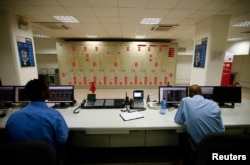Ethiopia opened its Gibe III dam in December 2016 in the lower Omo Valley as part of a large project that includes sugar and cotton plantations, as well as dams.
Water started collecting in a reservoir behind the dam in 2015, preventing it from flowing downstream to Lake Turkana in neighboring Kenya.
Human Rights Watch says little is being done by either government to mitigate the impact and that as the plantations are developed, even more water will be diverted from Turkana, which desperately requires it.
Human Rights Watch cites data finding Lake Turkana's water levels have dropped about 1.5 meters in the past two years, and the shoreline has receded as much as 1.7 kilometers in one key fishing ground since November 2014.
Food supplies affected
Felix Horne, HRW's senior researcher for Ethiopia and Eritrea, says the developments will seriously affect food supplies and livelihoods in the Omo Valley and Lake Turkana.
“What all the developments have in common is that they use a lot of water,” said Horne. “And the 1.5-meter drop, that is the first of those water drops coming to fruition, so it is very worrying.”
Horne is referring to a 2012 prediction from independent hydrologists that once Gibe III was up and running, the water levels at Lake Turkana, which receives 90 percent of its water from the Omo River, would drop by 2 meters.They also expect water levels to drop by as much to 20 meters if the full development plans are completed.
Projects hurt people downstream
HRW argues these water projects are harmful enough to the people downstream, but climate change is exacerbating the problem.
“This the other sort of long-term threat to the people of Turkana, is climate change, and it is very clear from the climatic data, but also from talking to people there that the whole pattern of rainfall has shifted over time and the entire area is getting more dry,” said Horne. “There is less grazing land, there is less water available and the population is also growing, so there is more conflict over what resources are left.”
The decrease in resources is making it even more difficult for people to earn a living, said Ikal Ang'elei, director and founder of Friends of Lake Turkana. She says some pastoralists already had switched from animals to fishing, once livestock became less sustainable due to decreased grazing land and other factors.
“Now you are seeing that the fishing they were using as a livelihood now seems to be under pressure, most likely it is going to be destroyed,” said Ang'elei. “So you see the worry among these communities, constantly asking, ‘Why is the government doing this to us?’”
No comment from Kenya
Human Rights Watch says Kenya's government has not pressed Ethiopia on damage mitigation and has not informed communities about the project's impact. It also says Ethiopia has shown scant regard' for those reliant on the Omo River and Lake Turkana for their livelihoods.
Officials with Kenya's Ministry of Water and Irrigation were unavailable for comment, and attempts to reach Ethiopian government officials for a response were unsuccessful.
The Ethiopian government has announced it will build Gibe IV, a new $1.6-billion dam, which will produce more power than any other dam in Africa outside Ethiopia. A fifth dam also is being planned.








